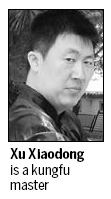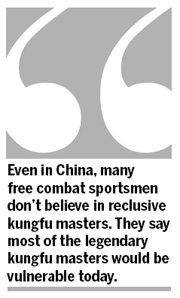Op-Ed Contributors
Kungfu needs ideas to fly into future
By Ku Ma (China Daily)
Updated: 2010-05-27 07:49
 |
Large Medium Small |

The popular movie, Ip Man 2, in which kungfu master Ye Wen beats a Western boxer easily, has aroused people's interest in Chinese martial arts.
The proliferation of kungfu films, however, does not reflect reality. The truth is it is hard to find a kungfu school in cities today, and more and more Chinese parents are sending their children to taekwondo dojo (training schools), which have mushroomed all over the place.
Internationally, Chinese kungfu does not enjoy much edge over Muay Thai (Thai boxing) or boxing. Even in China, many free combat sportsmen don't believe in reclusive kungfu masters. They say most of the legendary kungfu masters would be vulnerable today.
So, is kungfu dying? It certainly is on the decline, says Xu Xiaodong, a 38-year-old taichi chuan and baguang zhang (eight trigram palm) expert who has been practicing kungfu for nearly 30 years. But it would be unwise to copy the commercial model of taekwondo to revive it. Taichi chuan and baguang zhang are forms of Chinese martial arts - or kungfu or wushu.
"Traditional wushu is more about self-cultivation and martial skills, and attaches great importance to heart training," Xu says. "One needs proper physical exercise and breathing exercises for peace of mind and body. Only when a kungfu master's heart, mind and body merge together will he be able to explode with astonishing power."
To prove his point, Xu cites an anecdote. Several years ago he met the baguang zhang grandmaster Yang Kun. Even before Xu could realize what the grandmaster was doing, he was lifted up horizontally and placed on a chair. Xu is 1.8 meters tall and weighs 85 kg, and Yang was just an 88-year-old man.
Citing his personal experience, Xu says he cannot agree with the popular notion that the traditional person-to-person method of teaching kungfu has pushed the Chinese martial art toward death. Standardizing kungfu will help promote it among ordinary people, just like the 24-move form has done for taichi chuan. A person would need a master, though, to teach him/her if he/she wants to improve or diversify his/her skills.
"One of kungfu's distinct characteristics is its diversity. Taichi chuan, for instance, has Yang, Chen, Wu and Sun styles and baguang zhang, Yin, Cheng, Liang and Fan."

"A good master needs to teach each student according to his own character, so that he can comprehend kungfu's essence and develop his own style," Xu says. It is not the way of teaching, but history, that is hindering kungfu's development.
Chinese martial arts are said to have originated during the Xia Dynasty more than 4,000 years ago. Unlike the elegant kungfu we get to see in films, ancient Chinese learned martial arts to defend themselves against or kill their enemies, and to learn hunting and military techniques, says Xu, the vice-secretary of Beijing Baguangzhang Association who was the runner-up in a 2006 kungfu contest in Beijing.
The fighting styles practised today took centuries to develop, after having incorporated forms that came into existence later. Some of these include Bagua, Drunken Boxing, Eagle Claw, Five Animals, Wing Chun and Taichi Chuan.
In ancient times, martial arts played an important role even in the transition of power. Whether it was the period of the Three Kingdom (AD 220-280) or the beginning of Tang Dynasty (AD 618-907), the emperors had many a dauntless general or marshal who could easily take on dozens of ordinary soldiers.
For foreigners, Bruce Lee was the ultimate icon of kungfu. But Chinese people are familiar with characters such as Guan Yu and Zhang Fei during the Thee Kingdom, and Qin Qiong and Yuchi Gong during the Tang Dynasty. Even Li Shimin, a Tang emperor, needed Shaoling monks' help to defeat his rival, Wang Shichong.
Chinese martial arts became very popular during the period between the fall of the Qing Dynasty (1644-1911) and the Japanese invasion, because many martial artists were encouraged to teach their art to ordinary citizens. Many people at that time considered martial arts as a means of expressing national pride and building a strong nation, Xu says.
The "cultural revolution" (1966-76), however, damaged many aspects of traditional Chinese life, including martial arts. The then government promoted the committee-regulated wushu to replace independent schools of martial arts. As a result, kungfu masters had to treat their art form more as a kind of performance than fighting skill.
Even after the film, Shaolin Temple (1982), intrigued many Chinese youths, including Xu, into learning kungfu, parents and teachers remained prejudiced against the martial art form, Xu says. "They banned wushu altogether, because they considered it rude."
Modern weapons have made fighting skills even less important. "For example, taichi chuan, now the favorite gentle and slow-motion exercise of senior citizens, is in fact a kind of martial art that can injure rivals seriously," Xu says. "The problem is not with kungfu itself, but with the fact that fewer people today have the need to learn fighting skills. Today's busy modern life, too, is an obstacle for kungfu, because it takes at least a decade's hard work to learn it properly. "The purpose of learning kungfu today is totally different from the old days In ancient times, people learned kungfu to defend themselves and thus to stay alive but now people learn it for reasons of health or fun, or because they love it."
"We have to face up to reality. History has changed a lot," Xu says. "Kungfu cannot play the role it did in ancient or medieval times. It has to carry new social responsibilities. For example, we can merge traditional kungfu and traditional Chinese medicine to exploit the martial art's function of improving a person's health. Or, we could use kungfu's close link with tradition to find the true meaning of Chinese culture. Or still we could marry kungfu and modern boxing to raise kungfu's fighting level."
Kungfu was born and elevated to ethereal levels out of necessity. But it will fly into the future on the effectiveness of notions.
(China Daily 05/27/2010 page9)